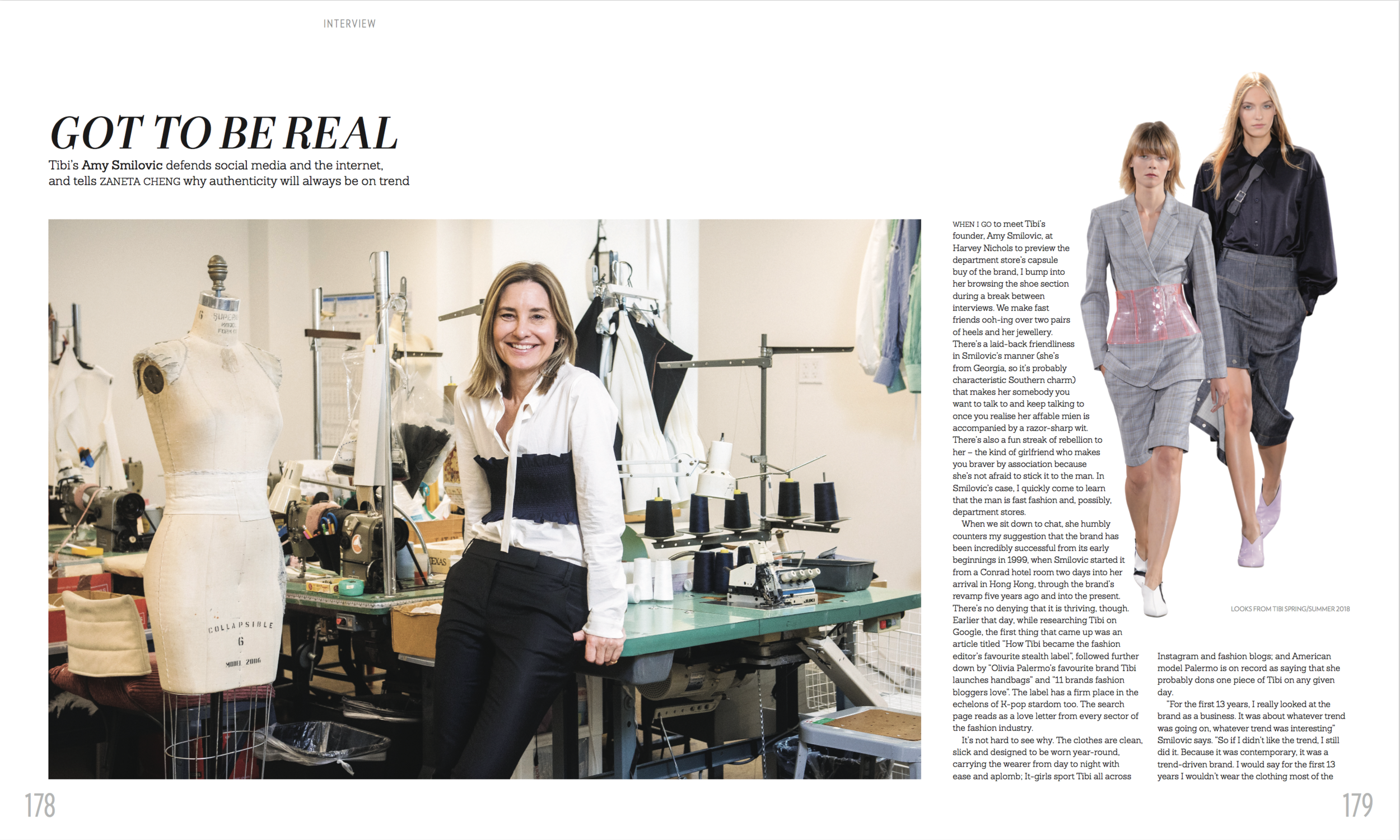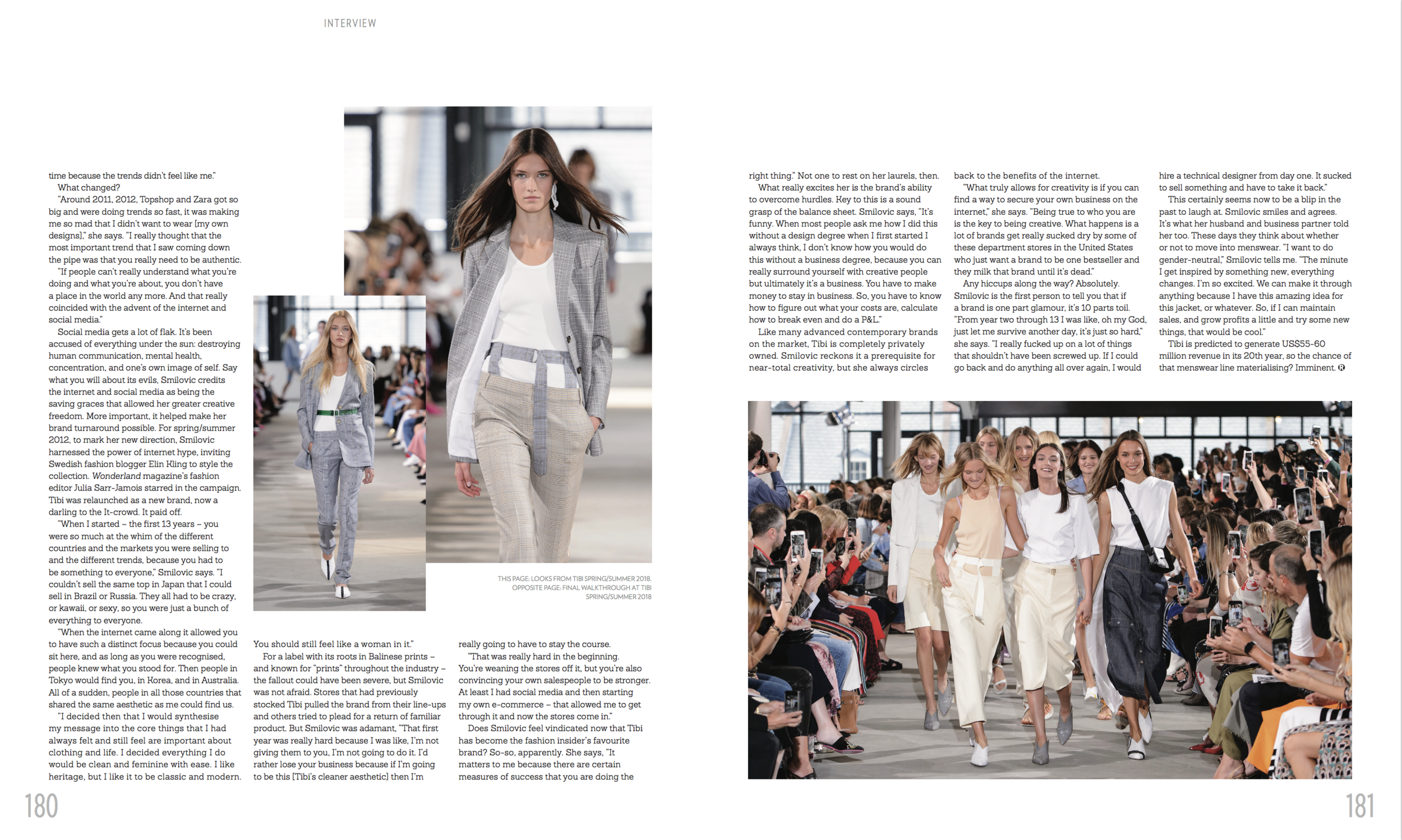Tibi Interview (Amy Smilovic) | Prestige Hong Kong (Mar 18)
Tibi’s Amy Smilovic defends social media and the internet, and tells zaneta cheng why authenticity will always be on trend
When I go to meet Tibi’s founder, Amy Smilovic, at Harvey Nichols to preview the department store’s capsule buy of the brand, I bump into her browsing the shoe section during a break between interviews. We make fast friends ooh-ing over two pairs of heels and her jewellery. There’s a laid-back friendliness in Smilovic’s manner (she’s from Georgia, so it’s probably characteristic Southern charm) that makes her somebody you want to talk to and keep talking to once you realise her affable mien is accompanied by a razor-sharp wit. There’s also a fun streak of rebellion to her – the kind of girlfriend who makes you braver by association because she’s not afraid to stick it to the man. In Smilovic’s case, I quickly come to learn that the man is fast fashion and, possibly, department stores.
When we sit down to chat, she humbly counters my suggestion that the brand has been incredibly successful from its early beginnings in 1999, when Smilovic started it from a Conrad hotel room two days into her arrival in Hong Kong, through the brand’s revamp five years ago and into the present.
There’s no denying that it is thriving, though. Earlier that day, while researching Tibi on Google, the first thing that came up was an article titled “How Tibi became the fashion editor’s favourite stealth label”, followed further down by “Olivia Palermo’s favourite brand Tibi launches handbags” and “11 brands fashion bloggers love”. The label has a firm place in the echelons of K-pop stardom too. The search page reads as a love letter from every sector of the fashion industry.
It’s not hard to see why. The clothes are clean, slick and designed to be worn year-round, carrying the wearer from day to night with ease and aplomb; It-girls sport Tibi all across Instagram and fashion blogs; and American model Palermo is on record as saying that she probably dons one piece of Tibi on any given day.
“For the first 13 years, I really looked at the brand as a business. It was about whatever trend was going on, whatever trend was interesting” Smilovic says. “So if I didn’t like the trend, I still did it. Because it was contemporary, it was a trend-driven brand. I would say for the first 13 years I wouldn’t wear the clothing most of the time because the trends didn’t feel like me.”
What changed?
“Around 2011, 2012, Topshop and Zara got so big and were doing trends so fast, it was making me so mad that I didn’t want to wear [my own designs],” she says. “I really thought that the most important trend that I saw coming down the pipe was that you really need to be authentic.
“If people can’t really understand what you’re doing and what you’re about, you don’t have a place in the world any more. And that really coincided with the advent of the internet and social media.”
Social media gets a lot of flak. It’s been accused of everything under the sun: destroying human communication, mental health, concentration, and one’s own image of self. Say what you will about its evils, Smilovic credits the internet and social media as being the saving graces that allowed her greater creative freedom. More important, it helped make her brand turnaround possible. For spring/summer 2012, to mark her new direction, Smilovic harnessed the power of internet hype, inviting Swedish fashion blogger Elin Kling to style the collection. Wonderland magazine’s fashion editor Julia Sarr-Jamois starred in the campaign. Tibi was relaunched as a new brand, now a darling to the It-crowd. It paid off.
“When I started – the first 13 years – you were so much at the whim of the different countries and the markets you were selling to and the different trends, because you had to be something to everyone,” Smilovic says. “I couldn’t sell the same top in Japan that I could sell in Brazil or Russia. They all had to be crazy, or kawaii, or sexy, so you were just a bunch of everything to everyone.
“When the internet came along it allowed you to have such a distinct focus because you could sit here, and as long as you were recognised, people knew what you stood for. Then people in Tokyo would find you, in Korea, and in Australia. All of a sudden, people in all those countries that shared the same aesthetic as me could find us.
“I decided then that I would synthesise my message into the core things that I had always felt and still feel are important about clothing and life. I decided everything I do would be clean and feminine with ease. I like heritage, but I like it to be classic and modern. You should still feel like a woman in it.”
For a label with its roots in Balinese prints – and known for “prints” throughout the industry – the fallout could have been severe, but Smilovic was not afraid. Stores that had previously stocked Tibi pulled the brand from their line-ups and others tried to plead for a return of familiar product. But Smilovic was adamant, “That first year was really hard because I was like, I’m not giving them to you, I’m not going to do it. I’d rather lose your business because if I’m going to be this [Tibi’s cleaner aesthetic] then I’m really going to have to stay the course.
“That was really hard in the beginning. You’re weaning the stores off it, but you’re also convincing your own salespeople to be stronger. At least I had social media and then starting my own e-commerce – that allowed me to get through it and now the stores come in.”
Does Smilovic feel vindicated now that Tibi has become the fashion insider’s favourite brand? So-so, apparently. She says, “It matters to me because there are certain measures of success that you are doing the right thing.” Not one to rest on her laurels, then.
What really excites her is the brand’s ability to overcome hurdles. Key to this is a sound grasp of the balance sheet. Smilovic says, “It’s funny. When most people ask me how I did this without a design degree when I first started I always think, I don’t know how you would do this without a business degree, because you can really surround yourself with creative people but ultimately it’s a business. You have to make money to stay in business. So, you have to know how to figure out what your costs are, calculate how to break even and do a P&L.”
Like many advanced contemporary brands on the market, Tibi is completely privately owned. Smilovic reckons it a prerequisite for near-total creativity, but she always circles back to the benefits of the internet.
“What truly allows for creativity is if you can find a way to secure your own business on the internet,” she says. “Being true to who you are is the key to being creative. What happens is a lot of brands get really sucked dry by some of these department stores in the United States who just want a brand to be one bestseller and they milk that brand until it’s dead.”
Any hiccups along the way? Absolutely. Smilovic is the first person to tell you that if a brand is one part glamour, it’s 10 parts toil. “From year two through 13 I was like, oh my God, just let me survive another day, it’s just so hard,” she says. “I really fucked up on a lot of things that shouldn’t have been screwed up. If I could go back and do anything all over again, I would hire a technical designer from day one. It sucked to sell something and have to take it back.”
This certainly seems now to be a blip in the past to laugh at. Smilovic smiles and agrees. It’s what her husband and business partner told her too. These days they think about whether or not to move into menswear. “I want to do gender-neutral,” Smilovic tells me. “The minute I get inspired by something new, everything changes. I’m so excited. We can make it through anything because I have this amazing idea for this jacket, or whatever. So, if I can maintain sales, and grow profits a little and try some new things, that would be cool.”
Tibi is predicted to generate US$55-60 million revenue in its 20th year, so the chance of that menswear line materialising? Imminent.

